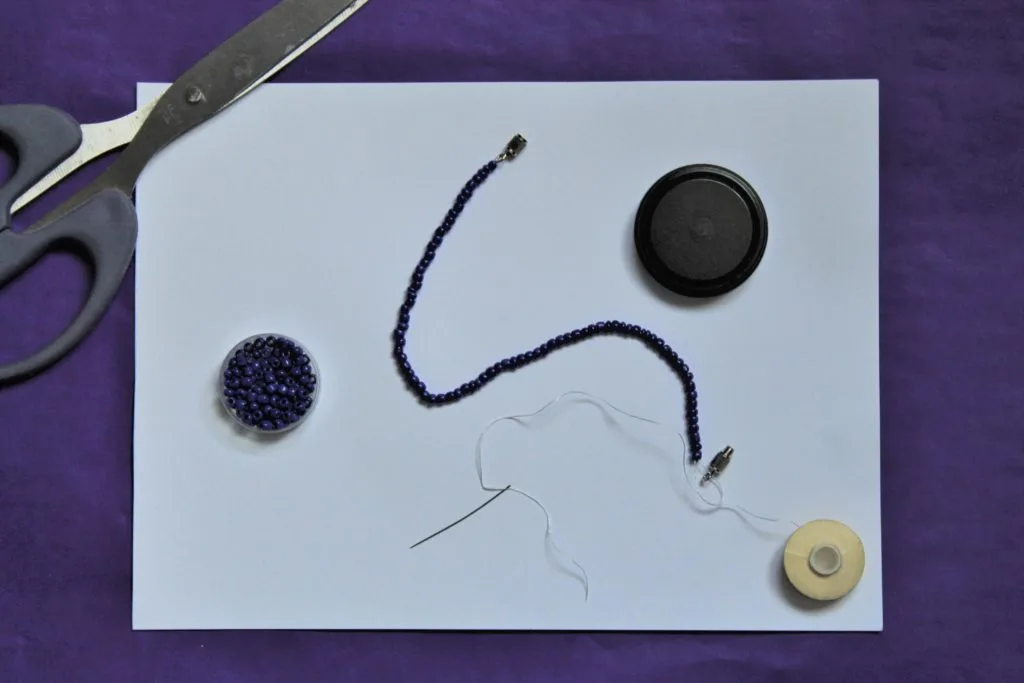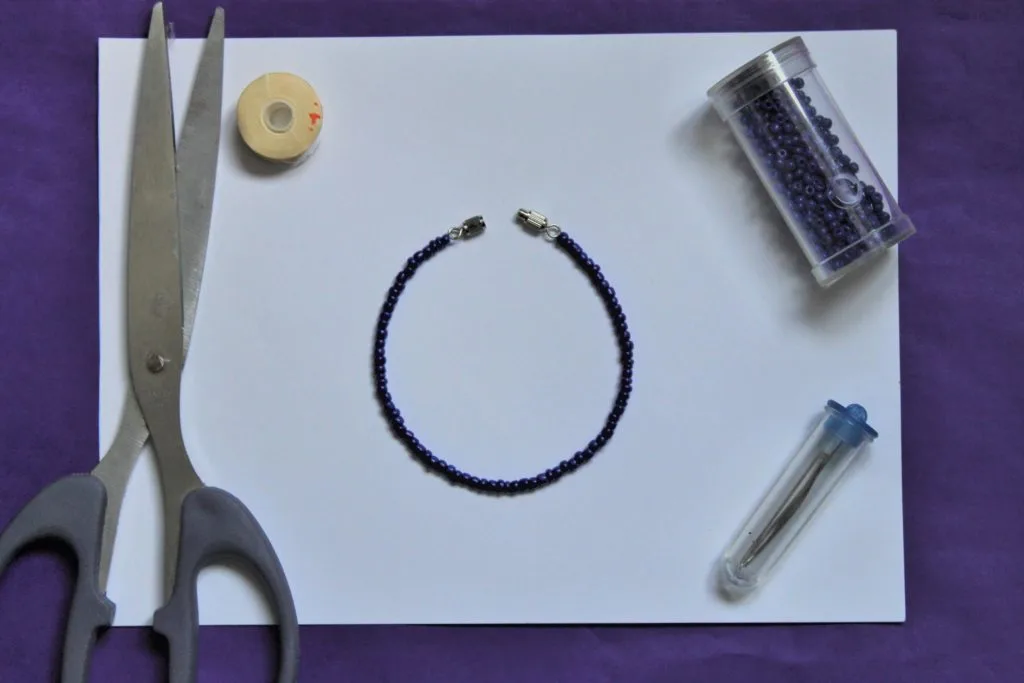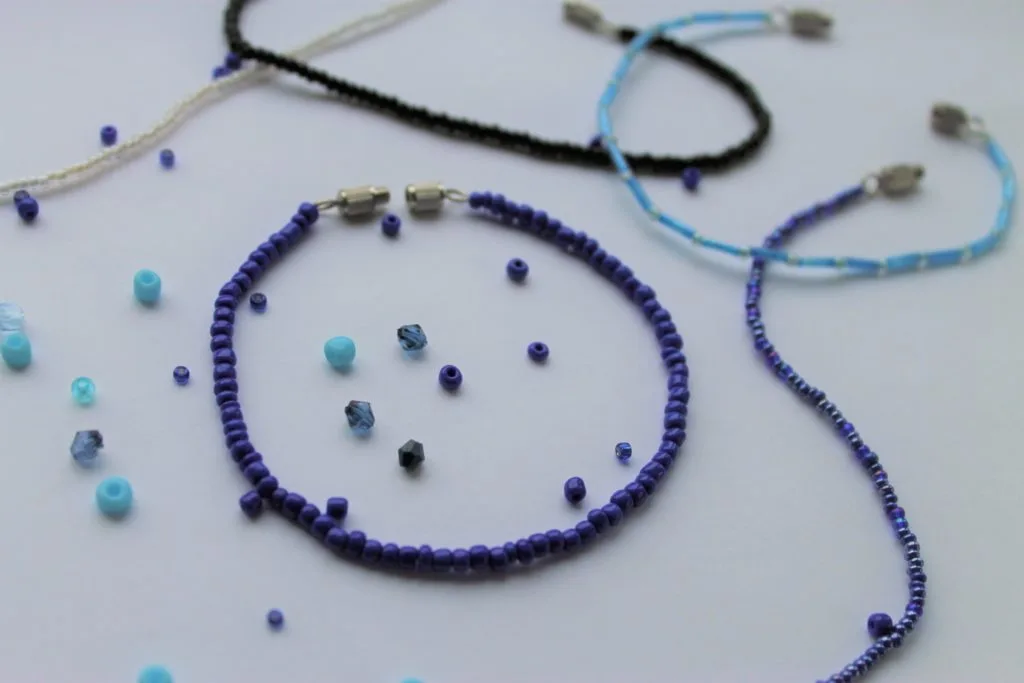Learning how to make jewellery yourself doesn’t have to be time consuming or complex, in fact some of my favourite pieces have been made in about 20 minutes (or the length of an episode of The Big Bang Theory). Crafting jewellery is a therapeutic and rewarding hobby that can easily be picked up by anyone and can be done in the comfort of your own home (or in my case a den).
A simple piece of jewellery like a bracelet or beaded choker doesn’t need big centre pieces, bold colours or even a pattern. A single strand of dainty glass beads around your wrist or neck, perfectly co-ordinated with your outfit and at exactly the right length to feel comfortable, can really make you feel confident, feminine and well… proud of yourself.
This is the method I’ve used from the very beginning of my jewellery hobby, although it has been refined slightly as I got more experienced. The majority of the simple jewellery pieces you will find in my Etsy store are made using this method. As for the more complex jewellery pieces, they’ve all grown from jewellery made in this method. As you become more comfortable you will find yourself experimenting with different techniques and materials. That is when you can really add your own personal flair to your work!
I would encourage you to start with this DIY beaded bracelets tutorial before moving onto wires, crimp beads and a whole other range of different materials as it will give you a brilliant and rewarding way to learn the basics. But if you choose another method that is absolutely fine. This is what worked for me and I hope you will enjoy trying it out.
Other jewellery experts with guides online might want to start with more complex methods and materials, telling you what should be used for what and what you simply can’t do: they miss the point, I feel. You should enjoy making jewellery!
I always enjoy using this method, it’s simple and keeps my hands busy… I could thread in the dark after how many years I’ve been doing this. Hopefully it brings you the same enjoyment. When you have a simple, durable and elegant bit of handmade jewellery that you have crafted yourself I am sure you will likely get the jewellery making bug.
DIY Beaded Bracelets Tutorial
I’ll take you through how to craft your own simple bracelet step by step. First, gather your materials:
Small work surface that’s well lit – if like me, you want to be crafting while the TV is on, use a dinner tray or large, shallow container so your beads can’t roll off your lap or down the sides of the sofa.
Beads – I love using glass beads, not just for the shine but they feel cool when you put them on and tend to be more robust and higher quality than their plastic counterparts. For your first simple bracelet pick just 1 colour in 1 size. I recommend using seed beads, size 9/0 or 8/0. Any smaller and you’ll find you need to focus a lot harder, any larger and your bracelet will feel less dainty and more clunky. A brilliant shop to buy your beads is here. They have always given me great prices and fantastic service.
Clasp – I use twist clasps as they’re my favourite and don’t easily come undone once they’re on. You can use any clasp you like. For this simple tutorial, we’ll be wrapping the thread directly against the clasp but if you want to have it look a little more professional, consider using crimp beads (another blog post in the making) with wire.
Want to know how to make bracelets without clasps? If you don’t have a clasp, you’ll need to use elastic thread instead that you can simply tie in a loop and stretch over your hand. If you’re doing this, stop after Step 2, cut your bracelet thread free, tie it up, trim the ends and you’re ready to go!
Thread – I use a nylon type thread that is especially for jewellery making. It’s quite strong yet fine enough to pass through your size 9/0 beads two or three times (this is important later). You can buy the same Nymo thread that I use but Silamide is also a good option.
Beading needle – for beads as small as we’re using, you definitely need to use a needle or your thread is going to fray and cause all sorts of problems. I have a little plastic tube that I keep my needles in for storage, but when working on a jewellery piece I make sure to have a magnet nearby to stick my needle to rather than putting down on the tray and losing track of it.
Scissors – find them before you start so you don’t have to stop midway.
Step 1: Set Up Your Craft Place


Make sure that everything you need is in reach (TV remote, glass of wine etc.) so you’re not reaching for things and knocking beads everywhere. I’ve knocked whole trays of beads on to the floor too many times to count in the past. To save you pulling out your hair with frustration you should be organised!
Then set up your craft place as shown above, threading the needle but not cutting a piece of thread off the reel.
If you’re struggling to see what you’re doing, place a sheet of paper in the bottom of your tray or in your lap if the container is transparent: if you’re using dark beads, use a white piece of paper and if using lighter beads use darker paper.
Step 2: How to Thread Beads


I lay out a bracelet I know is the perfect length for me and lay my thread of beads next to it to compare. If your beads are smaller than your comparison bracelet, you can reduce the size of your new bracelet a little. For larger beads, make it slightly longer.
Step 3: Adding the Clasp


Using your needle, thread on the clasp, going through the loop a few times. Make sure you have enough thread loose between the needle and the clasp once it’s pulled through (see the picture) to be able to double back and reach the other end of your beads.
You can tie a knot here if you like, to ensure that the clasp will stay in place. Then start to double back, threading through all the beads in reverse – be very careful not to miss any or you’ll end up with a bumpy bracelet. When you reach the other end, do a check back to ensure that there are no missed beads.


When first learning how to make bracelets, use this method when it comes to the clasp because it just makes the whole process a lot more fluid, plus the end result is nicer and stronger. If you simply tied the ends of the thread to each clasp, you’re going to have a visible knot, which is fine but not as durable.
I remember one particular time when I had simply tied the end to the clasp. The bracelet just snapped at the knot and beads went everywhere across the car park I was walking through. To avoid that happening to you, make sure you follow my method instead, it is a lot stronger.
Step 4: Finishing the Clasp


Add the other piece of the clasp and tie as you can see in the picture. Make sure that the thread is pulled taut, so your beads aren’t sliding around showing the thread beneath… but also make sure it’s not too tight so that it’s causing tension on the thread from the beads.


You should still have some thread left on the needle, so once again, double back. Thread backwards onto, say 5 or 10 beads, then tie a double knot. It should slide right between the beads and be invisible. Then, thread another 5 or 10 beads along and tie again. Do this several times or as many times as your piece of thread allows, then you can simply cut the thread as close to the beads as possible.
Cut your bracelet free from the reel. If the thread on the needle end was quite short, cut so the reel end is longer. Thread your needle on and start to double back again, tying knots as you go but in different places to the other thread. Cut off in the same manner.


By doing this, your thread has to untie itself in several places to come undone, and the ends of your bracelet at the clasp become one continuous piece of thread without an end to fray or come loose. Don’t worry, all knots and ends are hidden.
Here’s what my finished bracelet looks like:


Don’t forget to leave a comment with any questions or suggestions to help others learning how to make jewellery. Follow me on Instagram @izzysden to see more beautiful handcrafted jewellery pieces.
